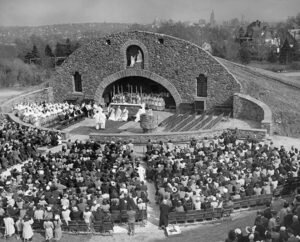by The Cowl Editor on February 3, 2017
News

By Marla Gagne
News Co-Editor
In 1948, Fr. Charles H. McKenna, O.P., a local Rhode Islander and Providence College alumnus, set out to build a memorial that would not only honor the dead, but also be a place of peace and comfort for the living— and he did just that.
St. Dominic Chapel is an integral part of daily life for PC students; where they can go to mass, meet with Friars, and hang out with students. But before the Chapel existed, the center of student life and religion was the grotto.
Adjacent to the chapel is a piece of the current War Memorial Grotto, originally created in 1948 to honor the fallen Providence College men during World War II. Three thousand, three hundred men, both alumni and current students, enlisted in the armed forces between 1941-1945; 69 of those men never returned home.
Fr. McKenna, a PC alumus and Dominican from Pawtucket, decided that these men should never be forgotten. Serving as the chaplain of the student body in 1938, he headed a campaign to build the grotto.
According to the Phillips Memorial Library records, McKenna championed a vision that “encompassed the idea that this would be not just a memorial, but also a place where future generations of PC students could find a place of quiet refuge from their hectic daily lives.” Still the center of daily life at PC, McKenna’s dream holds true 79 years later.
From its inception, the memorial has been a community effort. PC families, alumni, students, and fellow Rhode Islanders fundraised the majority of the money to build the memorial. One of the biggest fundraising events was a Penny Sale at the Rhode Island Atrium. The 1949 event drew in over 15,000 people, a record crowd, and was a great success, raising $41,000.
On-campus clubs also donated money from festivals and on-campus events. Students even took the lead when it came to the actual building of the memorial, often volunteering their time to help with construction. The students’ help and donated materials from the community greatly brought down construction costs.
On a windy day in May, less than a year after construction started, religious and government figures joined the ranks of 10,000 people to see the dedication. The College’s President, Father Robert J. Slavin, O.P., presided over the ceremony, while Father Harold C. Boyd, O.P., gave the homily.
His sermon focused on “The parallel of the martyrdom of motherhood of the heroes who gave their life for the preservation of freedom and the ideas of Christianity and the significance of the sublime example of the Mother of Christ.”
The memorial adorned two Italian carved Carrara marble statues at the center, showcasing St. Dominic receiving the rosary from Mary. There was a custom Wurlitzer organ, bronze altar appointments, and black granite Honor Roll panels that hung on both sides of the altar and read the names of the fallen students.
While the grotto would continue to serve as a somber reminder of the young lost, it also brought new life to the College. Students sunbathed on what was known as the “Beach Grotto,” played baseball or frisbee, or just brought blankets to hang out.
Old photos show crowds of students showing up in their bathing suits to enjoy good weather, live music, and parties.
The spot also held Sunday mass and evening mass, Diocesan Retreats, parents’ night, and the graduating class’ baccalaureate mass, among other services.
By the 1980s, the use of the grotto began to show. The campus saw the memorial’s “slow deterioration,” while also facing the problem that the “campus chapel facilities were clearly inadequate to meet the spiritual needs of a growing student body.”
The Ad Hoc Committee for the War Memorial Grotto under the College’s president Fr. John F. Cunningham, O.P., decided to keep “the key components of the Grotto while constructing a new campus chapel.”
The 117 foot chapel was inspired by Byzantine and Italian structures and can hold 600 people.
Many structures were made in Italy, 45 stained glassed windows adorned the walls, and the relics of saints, such as St. Catherine of Siena, St. Thomas Aquinas, St. Dominic, St. Agnes, and Blessed Melchior are entombed in the chapel’s altar.
By 2001, the chapel and new memorial were completed. Adjacent to the chapel lies the new memorial, one third of the original size, and still possesses the same stonework, statuary, and memorial plaques.
The grotto, although not the massive structure it once was, still continues to hold the memory of fallen students and is an everyday part of current PC life.
By 2001, the chapel and new memorial were completed. Adjacent to the chapel lies the new memorial, one third of the original size, and still possesses the same stonework, statuary, and memorial plaques.
The grotto, although not the massive structure it once was, continues to hold the memory of fallen students and be an everyday part of current PC life.